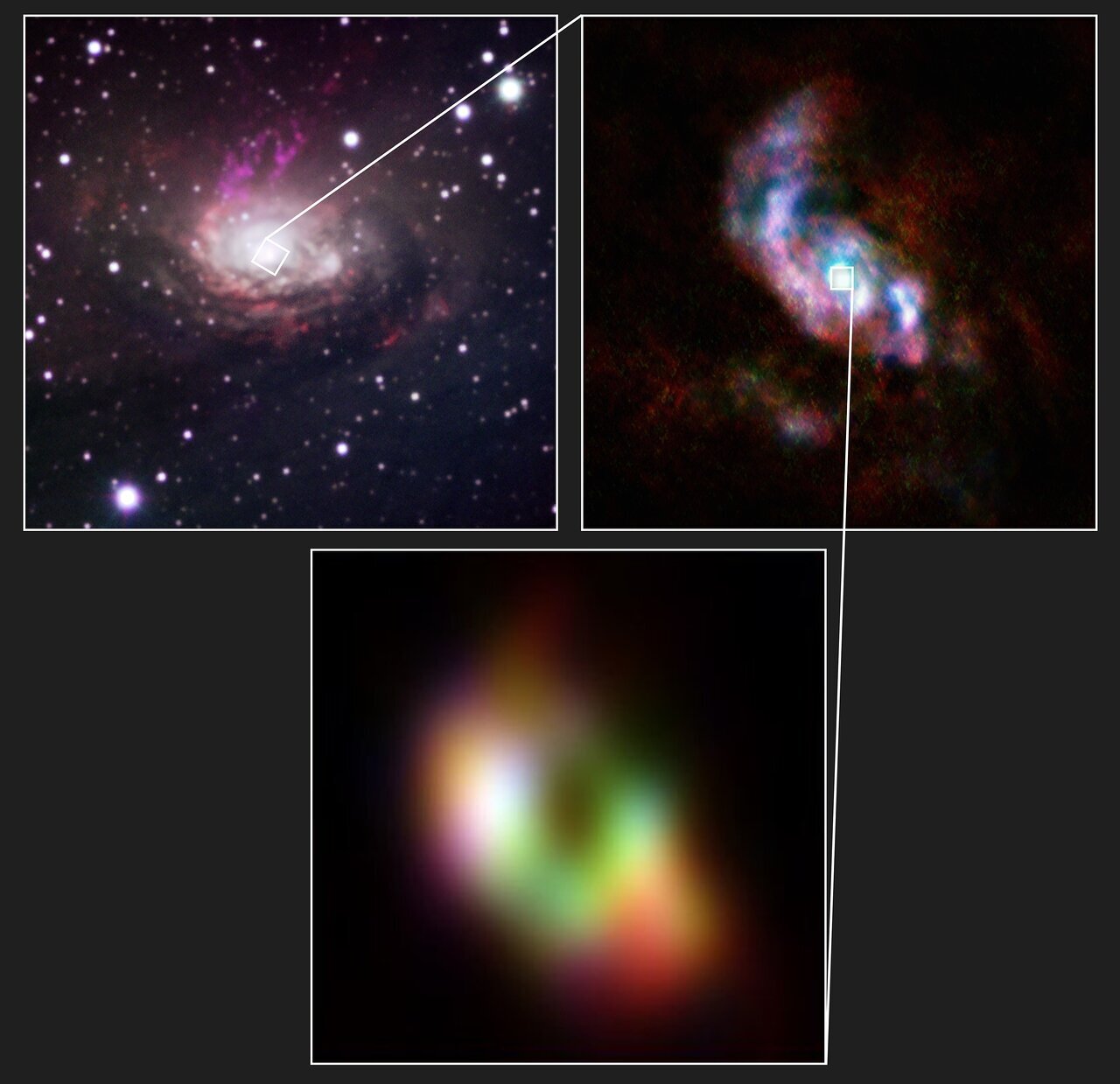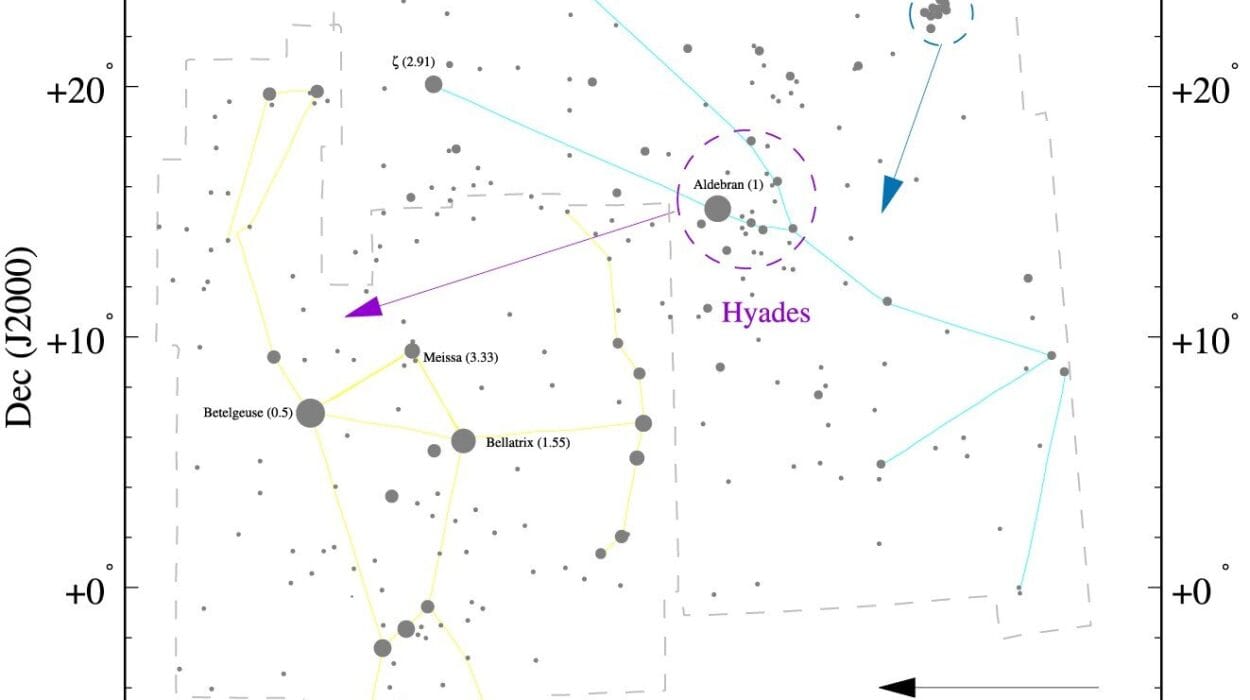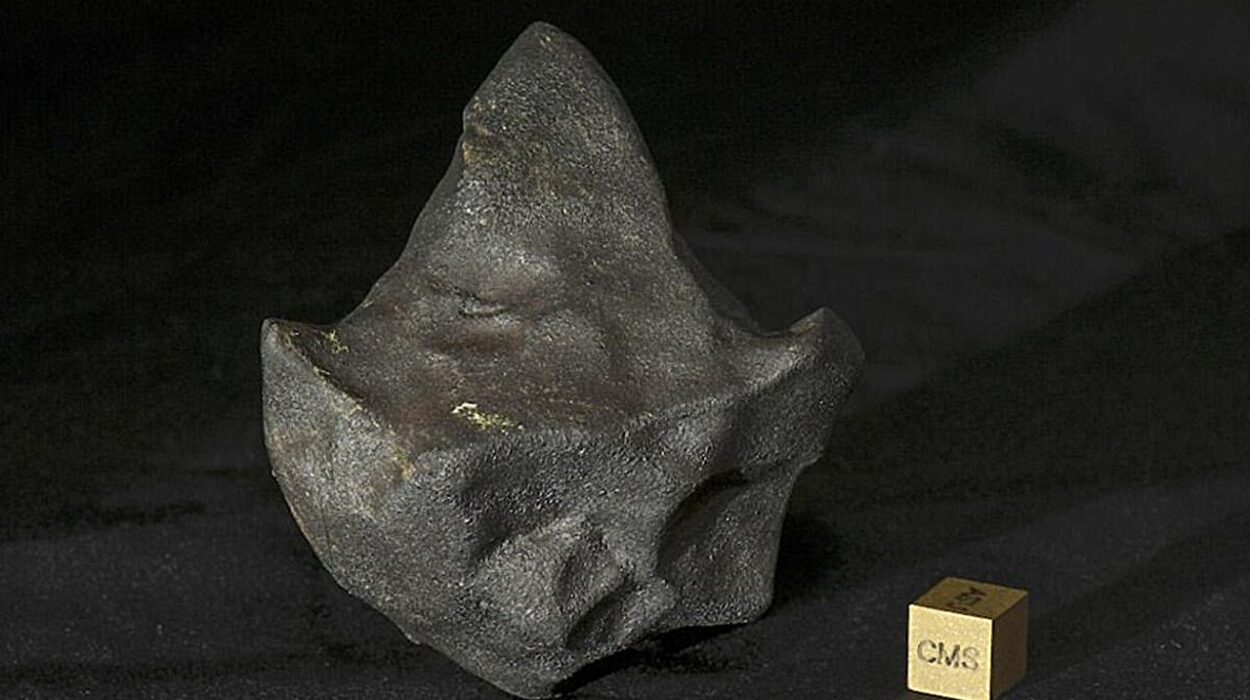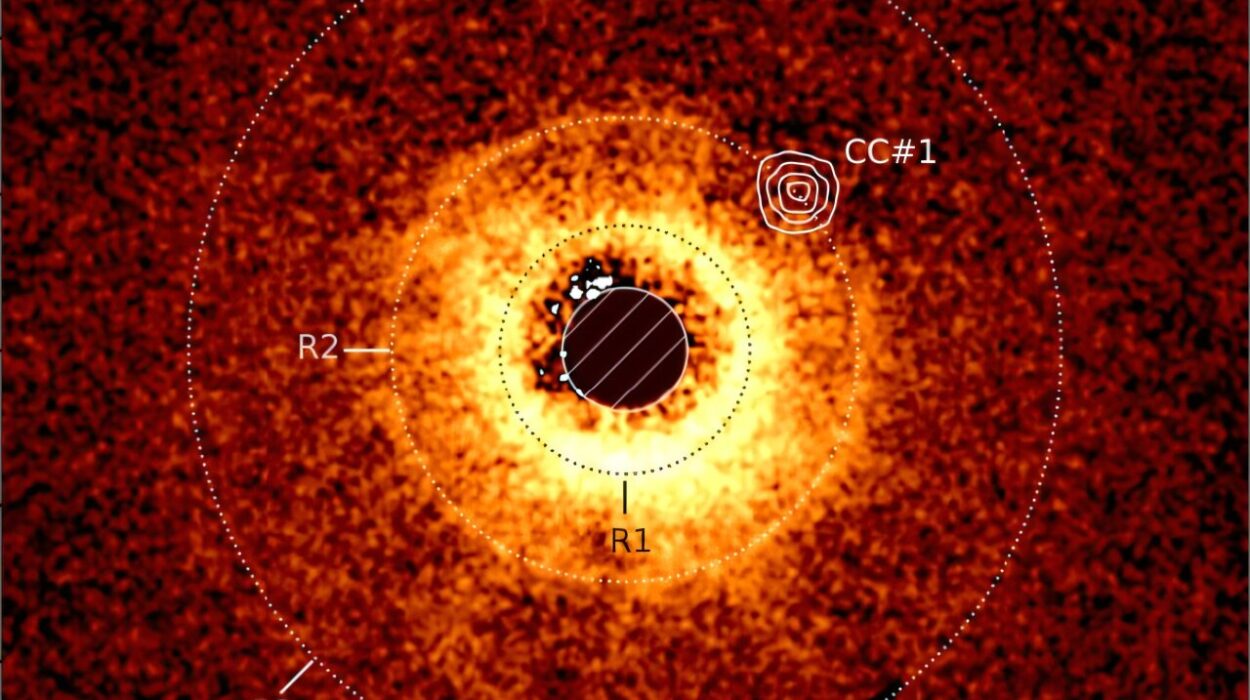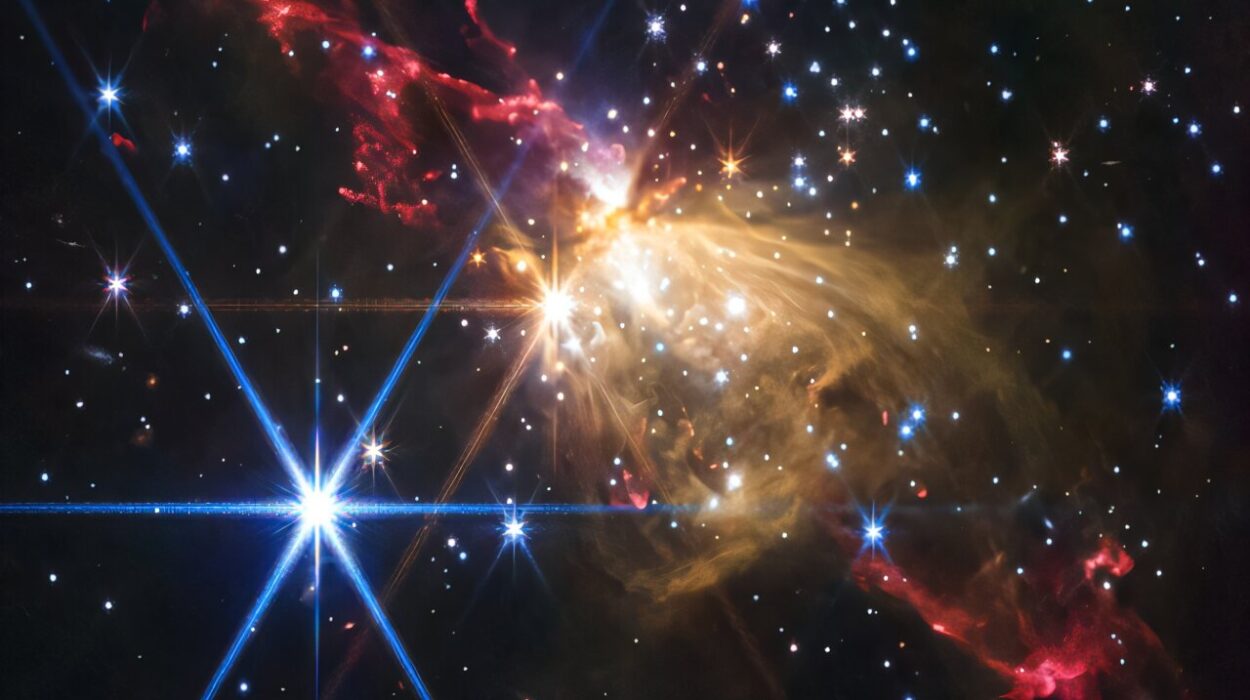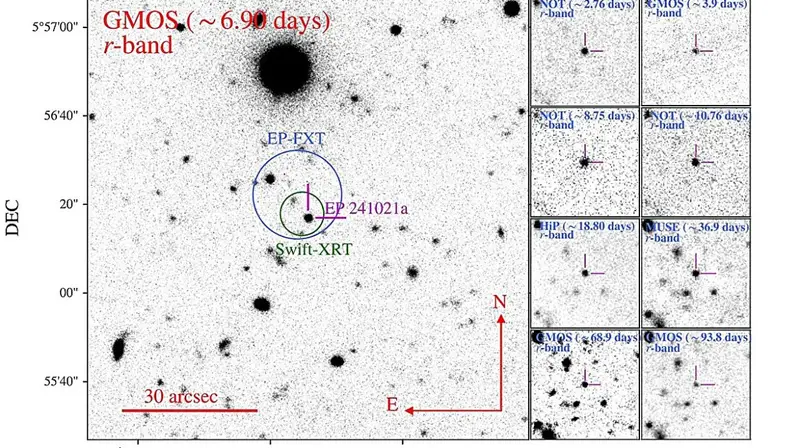Thirteen million light-years away, beyond the hazy curtain of our own Milky Way, lies a galaxy that has been quietly concealing a cosmic drama. The Circinus galaxy — a dusty, active spiral system in the southern sky — has finally given astronomers a clear view of how its central supermassive black hole feeds. And what they’ve found is both mesmerizing and humbling: two massive spiral arms of gas winding inward like celestial rivers, feeding the dark heart at the galaxy’s center.
This discovery, led by Wout Goesaert of Leiden University and his international team, offers an intimate glimpse into one of the universe’s most mysterious phenomena — how black holes “eat.” Using the powerful ALMA observatory in Chile, the researchers have shown that these spiraling gas structures act as cosmic feeding channels, guiding material toward the central black hole. But as with many cosmic tales, the ending is far from straightforward: only a tiny fraction of this material ever makes it to the event horizon.
The Cosmic Appetite of Black Holes
Supermassive black holes, those titans of gravity that anchor galaxies, are notorious for their appetite. They consume gas, dust, and sometimes even stars that venture too close. Yet, despite their immense hunger, they are surprisingly inefficient eaters. Most of the material swirling around them never crosses the point of no return. Instead, much of it is heated, disrupted, or flung back into space in colossal outflows.
The new study on Circinus confirms this picture — and adds a stunning new detail. The black hole there, which weighs millions of times more than our Sun, is fed by two majestic spiral arms made of gas. These arms funnel material inward at staggering speeds — up to 150,000 kilometers per hour. But in the end, only about 12 percent of that matter actually disappears into the black hole. The rest is hurled away, creating a cosmic cycle of inflow and outflow that both starves and sustains the galaxy.
Seeing the Invisible
Capturing this process was no easy feat. The Circinus galaxy, though relatively close by cosmic standards, was only discovered in 1977 — hidden behind the bright, dusty plane of our Milky Way. To peer through that cosmic veil, astronomers turned to the Atacama Large Millimeter/submillimeter Array (ALMA) — a network of radio telescopes perched high in Chile’s Atacama Desert.
ALMA doesn’t capture light the way our eyes do. Instead, it detects millimeter and submillimeter wavelengths — the faint thermal glow of gas and dust in deep space. By combining data from dozens of individual antennas, it can map regions of space with extraordinary precision, even where optical telescopes are blind.
When Goesaert and his colleagues analyzed the ALMA data, they noticed something remarkable. The gas near the black hole wasn’t arranged in a simple disk, as commonly depicted in illustrations. Instead, it appeared to follow two spiral paths inward — like water swirling down a drain in slow motion.
“In cartoons, you sometimes see a disk of gas disappearing into a black hole as if it were a whirlpool,” Goesaert explained. “However, if there is no supply channel, such a disk will continue to spin around forever. So you need a passageway of some kind. And that’s where our spiral arms come into play.”
A Race Against Rival Discoveries
The path to this revelation wasn’t straightforward. Just as Goesaert began analyzing the data in 2023 during his master’s research, another group published a paper on the same galaxy and the same black hole. For a moment, it seemed that their work might be eclipsed.
His supervisor, Dr. Violette Impellizzeri of ASTRON (the Netherlands Institute for Radio Astronomy), recalls that tense moment: “That worried us. But we decided not to give up. We delved deeper into the data, looked more closely, and searched for more details.”
That decision paid off. By using additional ALMA observations and more advanced modeling techniques, Goesaert’s team uncovered the twin spiral structures that had gone unnoticed. These arms, they realized, are the missing link — the conduits through which matter flows inward toward the black hole.
A Cosmic Tug of War
The results paint a picture of a turbulent cosmic environment. Gas races inward along the spiral arms, colliding, heating, and compressing as it moves closer to the black hole. Yet much of it doesn’t make it to the end. Somewhere in the chaotic inner region, powerful winds and radiation blast much of the material back outward.
This means the black hole is caught in a kind of tug of war — between gravity pulling gas in and energetic feedback pushing it away. The balance between these forces determines how the galaxy evolves. When the black hole consumes more material, it grows more active, emitting intense radiation that can suppress star formation. When it consumes less, the galaxy’s gas can cool and condense, giving birth to new stars.
In the case of Circinus, with 88 percent of the infalling gas being ejected, it seems the black hole is in a restrained phase — nibbling rather than devouring. Yet even that small fraction of infalling matter is enough to power intense radiation from the galaxy’s center, making it one of the closest examples of an “active galactic nucleus.”
The Mystery of the Ejected Matter
One of the most intriguing questions raised by the study is what happens to the gas that doesn’t fall in. Does it simply drift away, lost to space? Or does it rain back down, perhaps triggering new waves of star formation in the galaxy’s outskirts?
Goesaert and his team are determined to find out. The answers could reshape our understanding of how galaxies grow and evolve over billions of years. The material that escapes a black hole’s grasp isn’t wasted — it becomes part of the cosmic cycle, enriching interstellar space with heavier elements and seeding future generations of stars and planets.
As Goesaert puts it, “The initial results are begging for more. Why does so little matter reach the black hole? Do all supermassive black holes have spiral arms like this? Does the ejected matter fall back, or does it trigger new life elsewhere in the galaxy?”
Peering Deeper into the Abyss
To answer those questions, astronomers will soon turn to two extraordinary instruments: the Event Horizon Telescope (EHT) and the Extremely Large Telescope (ELT).
The EHT, a global network of radio observatories, made history in 2019 when it captured the first-ever image of a black hole’s shadow in the galaxy M87. It has since produced similar images of Sagittarius A*, the black hole at the heart of the Milky Way. Future observations could resolve even finer details around Circinus’s black hole, revealing how those spiral arms behave near the event horizon.
Meanwhile, the ELT — now under construction in Chile — will be the largest optical telescope on Earth, capable of observing faint galactic centers with unparalleled resolution. With its help, scientists hope to watch the cosmic feeding process unfold in real time, linking the small-scale mechanics of black hole accretion to the grand-scale evolution of galaxies.
The Cosmic Lesson of Circinus
The discovery in the Circinus galaxy is more than just another astronomical finding. It’s a reminder that the universe is full of paradoxes — beauty born of chaos, order rising from violence. Black holes, the ultimate symbols of destruction, also shape creation. By swallowing and spitting out matter, they regulate how galaxies live, breathe, and shine.
The spiral arms around the Circinus black hole are not just channels of doom; they are part of a grand cosmic cycle — a dance of matter and energy that has been ongoing since the dawn of time. In their swirling motion lies a reflection of the galaxies themselves, and perhaps of life’s own rhythm: to draw in, to release, and to renew.
A Window Into the Dark
For centuries, black holes were mere mathematical curiosities — invisible monsters imagined by theory. Today, thanks to instruments like ALMA, we can not only detect them but also watch them feed, breathe, and shape their surroundings. The Circinus discovery is a milestone in this ongoing journey of understanding — one that brings us closer to unraveling how galaxies, and perhaps the universe itself, evolve.
Somewhere, deep within that hidden galaxy, two spiral arms continue to twist around an invisible core, guiding streams of gas toward an insatiable darkness. Most of that material will never make it, flung back into space in an eternal cycle of hunger and resistance. And yet, in that cosmic struggle, the universe writes one of its most profound stories — that even in the shadow of a black hole, creation and destruction are forever intertwined.
The Endless Curiosity of Humanity
Behind every discovery like this one lies another kind of wonder — the human spirit of curiosity. From a small university in the Netherlands to a vast desert in Chile, people are gazing into the cosmos, deciphering the language of light, and asking questions that reach beyond our world.
As Goesaert and his team prepare to publish their work in Astronomy & Astrophysics, their findings remind us of something timeless: that the universe is not only out there — it’s within us, too. Our atoms, born in the hearts of ancient stars, now build telescopes and ideas capable of understanding their origins.
In the end, the story of the Circinus black hole is not just about gravity or gas. It’s about connection — between galaxies and observers, between past and future, between mystery and discovery. It’s a story that begins in darkness but ends, always, in light.
More information: Wout M. Goesaert et al, Torus feeding and outflow launching in the active nucleus of the Circinus galaxy, arXiv (2025). DOI: 10.48550/arxiv.2510.05199
